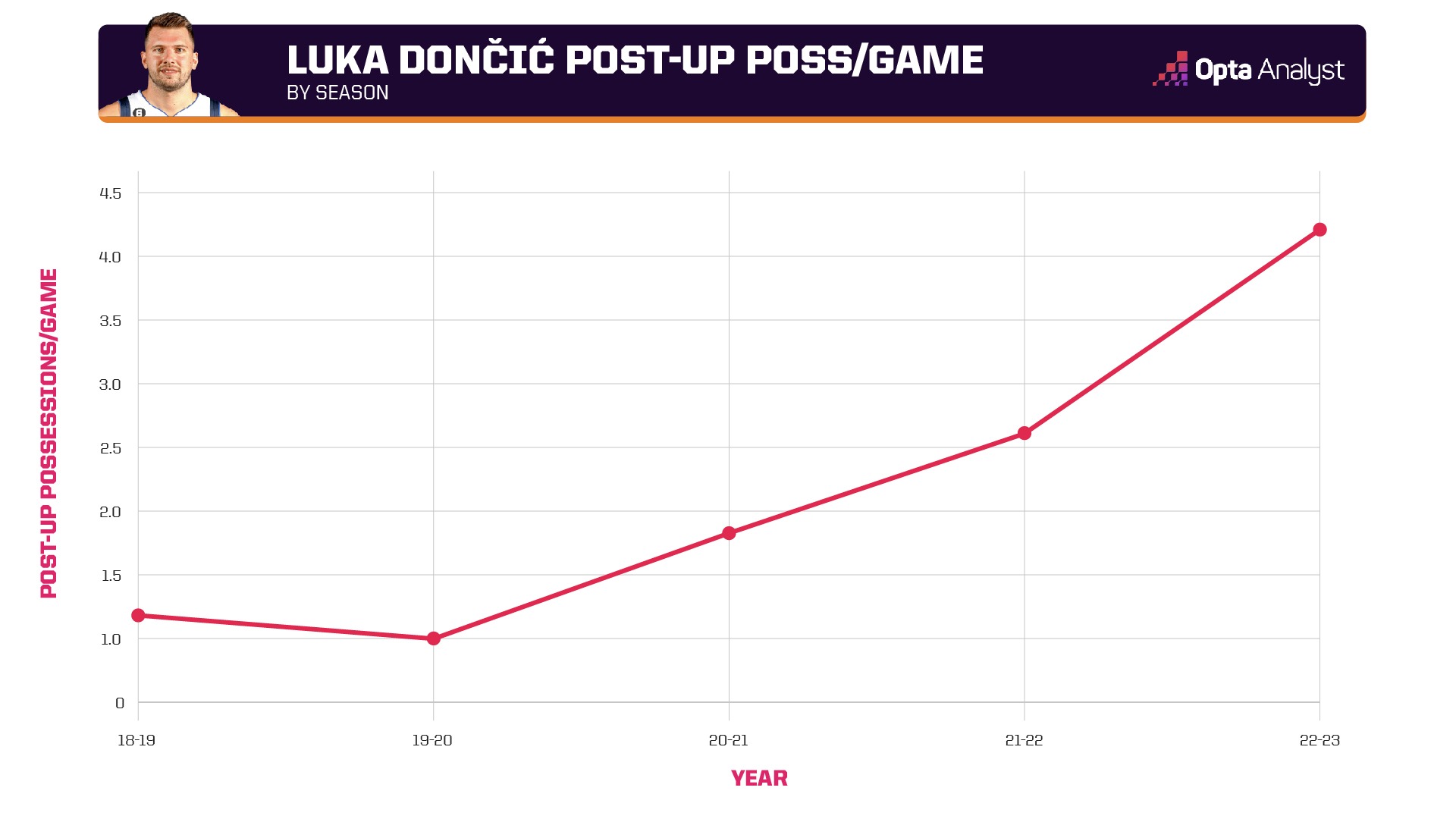The magical Luka Dončić has somehow managed to outdo himself again this season.
In Year 5, the 23-year-old playmaker is leading the NBA with a career-high 34.2 points per game to go along with 8.7 assists and a career-best 61.5 true shooting percentage while managing a usage rate of 38.9% (you guessed it, a career high).
That last output is especially impressive because not only is it the best mark in the NBA this season, but the fourth-highest usage rate in league history. He had a 60-point triple-double on Dec. 27 and has averaged a ridiculous 40.8 points, 10.9 rebounds and 8.8 assists over his last nine games.
Dončić also ranks seventh with a 4.3 offensive DRIP (a projection of what a player adds to a team’s plus-minus per 100 offensive possessions) among those with 700 minutes. And of the league’s top 20 players in overall DRIP, the Slovenian has the highest DELTA (improvement in DRIP since the start of the season) at 0.8.
In today’s game, Dončić is the epitome of the heliocentrism movement (the idea of allocating a large portion of scoring/playmaking duties to a single player). But the curious thing is that he has been the poster child for this revolution for some time.
So how is it that this year he has managed to expand his usage even further while simultaneously increasing his efficiency?
A little history lesson: the second-highest usage rate in NBA history belongs to James Harden, who in 2018-19 posted a usage rate of 40.7%. Under the guidance of offensive mastermind Mike D’Antoni, Harden and the Houston Rockets ran a hybrid pick-and-roll/isolation-heavy offensive attack. In 2018-19, Harden averaged a combined 23.8 possessions in which he ran pick-and-roll or isolation (per NBA.com).
The Dallas Mavericks follow a similar paradigm, often handing the keys over to Dončić and leaving the onus on him to initiate a majority of their offensive possessions. However, Dončić’s pick-and-roll/isolation rate is actually down a smidgeon to 18.9 from 19.3 last season.
So this doesn’t explain his uptick in usage. He’s also not generating more scoring opportunities through off-ball actions like cuts, handoffs, and screens.
What’s going on here?
Well, there are other forms of heliocentrism than the Hardenball we witnessed in the late 2010s. For instance, a different iteration of the Rockets, the bunch that won back-to-back titles in the mid-1990s, ran a heliocentric post offense through big man Hakeem Olajuwon.
The bare bones blueprint of the Olajuwon-led Rockets was a 4-out, 1-in attack that would dump the ball to The Dream in the post, wait for the double team to come, and have him spray it out to the open shooter on the perimeter (like this).
The Mavericks have blended the principles of the Hardenball Rockets with that of the Olajuwonball ones this season, leading to a career high in post-ups for Dončić.

This year, Dončić is averaging 4.2 post-up possessions per game (96th percentile volume). By increasing his load through something other than pick-and-roll/isolation possessions, Dallas is diversifying Dončić’s offensive palate, making it harder for teams to scheme against him (more on this later). That’s how he can increase his usage and efficiency simultaneously.
But wait, aren’t post-ups inefficient now?
Wrong! Recently, I explained how post-ups are not only back in style but are also efficient if they fall under one (or more) of the four factors. As we will soon explain, Dončić post-ups almost always meet the criteria necessary to fall under two of these factors.
One factor that makes a post-up efficient is whether said post-up is attacking a mismatch. Thanks to his height (6-foot-7) and husky frame (230 pounds), Dončić is able to bully frailer defenders in the interior, usually leading to an easy bucket or free throws.
If he meets a defender who is willing to stand up to him, he’s got a bevy of counters in his bag too. We mentioned Olajuwon earlier. Well, as fate would have it, Dončić has incorporated some Dream Shake into his game. And he even occasionally pays homage to Maverick fraternity brother Dirk Nowitzki by whipping out the one-legged fadeaway.
Those tricks are cool, but what really makes him deadly is the other one of the four factors he qualifies for. Post-ups are efficient when they involve a player who can attract a second defender, survey the floor, and find the open man.
Because Dončić is such a handful for most defenders, he typically forces the defense to send help, which leaves them vulnerable to his passing wizardry.
In this regard, his post-up game is more akin to a Magic Johnson, using his supreme vantage point, vision and feel to calmly analyze the layout of the battlefield and wisely decide the best course of action (whether that be to score, draw a foul, or pass).
Now, back to how this allows Dončić to cheat the laws of volume and efficiency. Generally speaking, when players increase their volume (their usage), it comes with a tradeoff of diminished efficiency.
That’s because this increase in volume is usually achieved by increasing the frequency in which they participate in their current actions. The more often you run a specific type of action, like, for instance, a pick-and-roll, the more looks a defense has against it and the more it can prepare to stop it.
A perfect example of this came last night in Dallas’ matchup with the Los Angeles Clippers. The Clippers (who have had plenty of experience against Dončić’s pick-and-rolls from their playoff clash in 2021) came in with a game plan to send hard doubles his way all night.
At first, this strategy worked, leading to a pedestrian (by Dončić’s standards) 7-of-16 shooting from the field with two turnovers through three quarters.
Then in the fourth quarter, the Mavericks started posting up Dončić more, and the doubles stopped coming because the Clippers were worried about his ability to dissect the defense from that viewpoint (even a lesser passer like Kawhi Leonard was able to identify advantages when doubled in the post).
This left poor Norman Powell to shadow Dončić in single coverage, and, well, you know the deal…
Despite ultimately losing, Dončić finished with 43 points on 68.8% true shooting, 11 rebounds and seven assists while shouldering a Harden-esque 40.1% usage rate.
Yet again, he managed improbable efficiency on otherworldly usage, and he did it by combining two forms of helioball (Harden’s and Hakeem’s) to create an updated version of the practice: double helioball.
It has led to a historic start as Dončić became only the fifth player in NBA history to average at least 45.0 points over five straight wins earlier this month. And he just might ride the approach all the way to league MVP honors.
